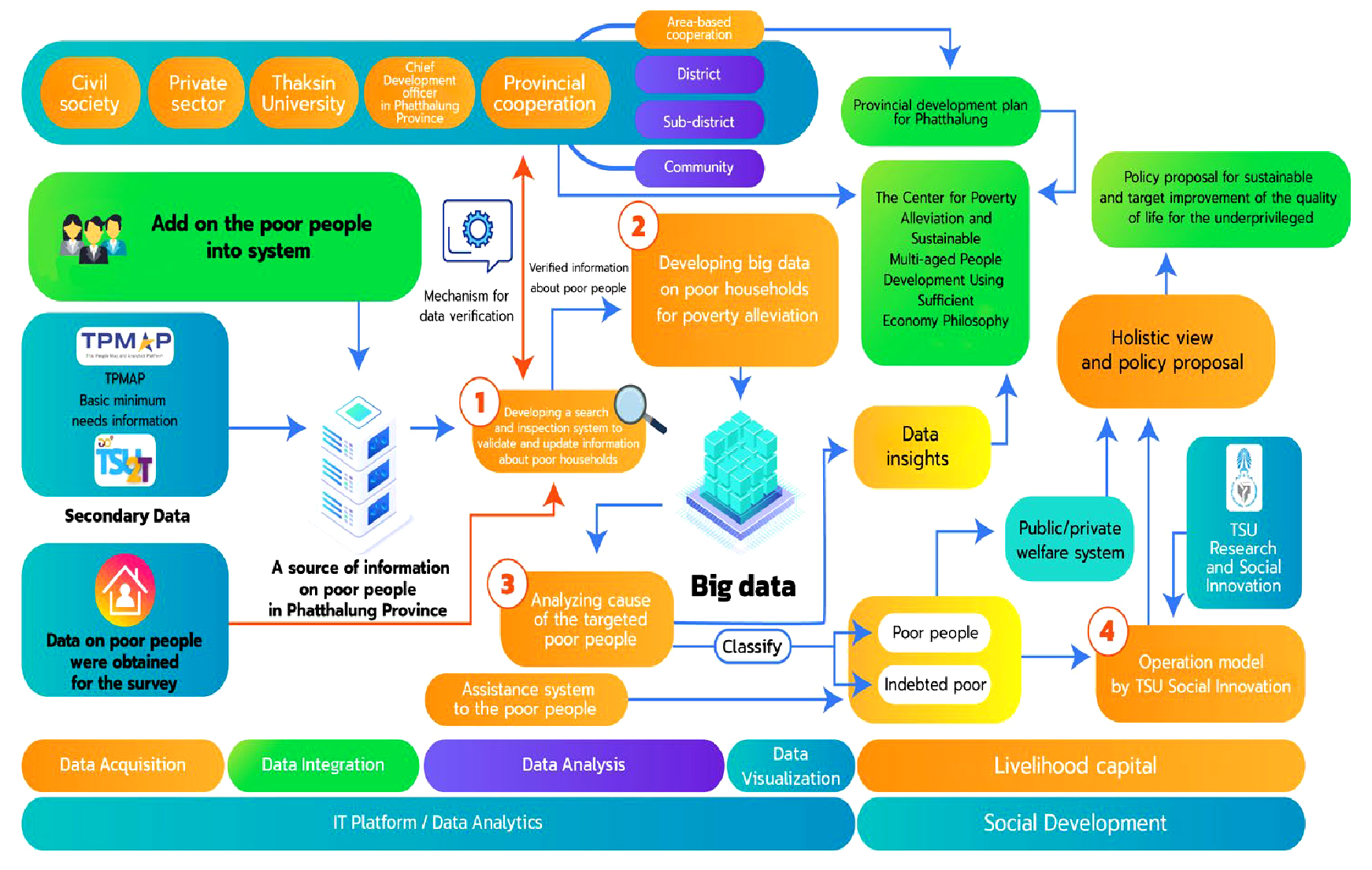Poverty Alleviation: A Case Study of Operating Model in Phatthalung Province
Main Article Content
Abstract
Phatthalung province has a low Human Achievement Index (HAI) in terms of household income and the highest ratio of poor people in Thailand. A collaborative process is developed In this research to drive area-based development and alleviate poverty in Phatthalung province. The main steps included in this process are: 1) Establishing cooperation between provincial and local agencies, 2) Developing a comprehensive surveying system for poor households in eleven districts of Phatthalung province, 3) Analyzing levels of sustainable livelihood capital and coordinating with social services to help those in need, and 4) Developing an operating model for locals to develop occupational and life skills. This operation helped integrate multilateral networks for poverty alleviation at the provincial level, particularly through the mechanism of the Center for Poverty Alleviation and Sustainable Multi-aged People Development Using Sufficient Economy Philosophy, a body that includes organizations from the government, the private sector, civil society, the public sector, and universities in the area. The survey in Phatthalung province revealed 14,212 households and 59,495 individuals living in poverty. We calculated scores reflecting the livelihood of these individuals based on five capital assets, revealing the following score for each capital: human capital was at 1.85 (difficult to live), physical capital was at 2.77 (livable), economic capital was at 2.20 (difficult to live), natural capital was at 2.72 (livable), and social capital was at 1.53 (very difficult to live). Following the results of this survey, revealing 9,597 households in need of assistance with either home repairs, the elderly, bedridden patients, or disabled persons, we coordinated with agencies responsible for the corresponding services. Finally, this data was used to develop a pilot model, the “Krajood model”, in Thalei Noi sub-district, Kuan Kanoon district, Phatthalung province. This model integrates the local wisdom of Krajood and community identity with modern science and innovation, therefore incorporating impoverished individuals into the value chain. The collaborative approach aimed to enhance skills, create opportunities, and uplift income prospects. This effort has not only developed a local partnership and working model for poverty alleviation but has also refined data tracking systems. These outcomes are envisioned as guiding principles for future area-based community development to effectively combat poverty in Phatthalung province.
Article Details

This work is licensed under a Creative Commons Attribution-NonCommercial-NoDerivatives 4.0 International License.
Area Based Development Research Journal values copyright protection and licensing to safeguard author rights and facilitate the appropriate dissemination of research. Our policies ensure openness, accessibility, and attribution. Authors retain copyright ownership, and articles are published under a Creative Commons Attribution License (CC BY), allowing sharing, adaptation, and proper attribution. Authors have the freedom to publish under the CC BY license, granting broad reuse and distribution permissions. The journal supports posting articles on third-party repositories, adhering to institutional and funding restrictions. Author guidelines detail copyright and licensing requirements, empowering authors with knowledge about their rights and responsibilities. These policies cultivate an environment of collaboration, openness, and responsible sharing, benefiting authors and the research community while honoring intellectual property rights.
References
Aueaungkul, A., Srichookiat, S., Khemakhunasai, P., Sampantamit, T., Kaewsuksaeng, S., & Jitnirat, N. (2023). Tube sedgebased poverty alleviation model of Thale Noi community, Phatthalung province. Area Based Development Research Journal, 15(3), 251–265. (in Thai).
Bangkok Post. (2021). Covid causes plunge into poverty. Retrieved November 12, 2021, from: https://www.bangkokpost.com/thailand/general/2171119/covid-causes-plunge-into-poverty.
Brynjolfsson, E., & McAfee, A. (2014). The second machine age: Work, progress, and prosperity in a time of brilliant technologies. New York: W. W. Norton & Company.
Davenport, T. H., & Harris, J. G. (2007). Competing on analytics: The new science of winning. USA: Harvard Business School Press.
Fiszbein, A., & Schady, N. (2009). Conditional cash transfers: Reducing present and future poverty. Washington DC: World Bank Publications.
Mayer-Schönberger, V., & Cukier, K. (2013). Big data: A revolution that will transform how we live, work, and think. USA: Houghton Mifflin Harcourt.
Meyer, B. D., & Rosenbaum, D. T. (2000). Making single mothers work: Recent tax and welfare policy and its effects. National Tax Journal, 53(4), 1027-1062.
Ministry of Higher Education, Science, Research and innovation. (2020). China’s path to poverty alleviation. Retrieved January 25, 2022, from: https://www.mhesi.go.th/index.php/en/content_page/item/3168-THA-CHN_Jan2564.html. (in Thai).
National Electronics and Computer Technology Center. (2018). Thai people map and analytics platform. Retrieved November 12, 2021, from: https://www.tpmap.in.th/. (in Thai).
Office of the National Economics and Social Development Council. (2020). Report on the poverty situation in 2019. Retrieved January 25, 2022, from: https://www.nesdc.go.th/article_attach/article_file_202011031 11407.pdf. (in Thai).
Office of the National Economic and Social Development Council. (2021). The thirteen national economic and social development plan (2023-2027). Retrieved January 25, 2022, from: https://www.nesdc.go.th/download/document/Yearend /2021/plan1.pdf. (in Thai).
Office of the National Economic and Social Development Council. (2022). Poverty and inequality report 2021. Retrieved October 23, 2023, from: https://www.nesdc.go.th/ewt_dl_link.php?nid=13081. (in Thai).
Office of the National Economics and Social Development Council. (2023). TPMAP logbook. Retrieved November 10, 2023, from: http://nscr.nesdc.go.th/new-tpmap-manual/.(in Thai).
Program Management Unit on Area Based Development. (2022). Annual report program management unit on area based development. Bangkok: Program Management Unit on Area Based Development. (in Thai).
Program Management Unit on Area Based Development. (2023). PPPConnext. Retrieved November 25, 2023, from: http://www.ppaos.com/ppaos/frontend/web/. (in Thai).
Provost, F., & Fawcett, T. (2013). Data science for business: What you need to know about data mining and data-analytic thinking. USA: O’Reilly Media.
Sen, A. (1999). Development as freedom. New York: Random House.
Smith, C., & Nairn, K. (2016). Breaking the cycle of poverty: Family start evaluation final report. Retrieved November 12, 2021, from: https://www.msd.govt.nz/about-msd-and-our-work/publications-resources/evaluation/family-start-evaluation-report.HTML.
United Nations. (2015). Transforming our world: The 2030 agenda for sustainable development. Retrieved November 12, 2021, from: https://sustainabledevelopment.un.org/post2015/transformingourworld.
Wang, J., & Lowatcharin, G. (2020). Implementing targeted poverty alleviation policy of the People’s Republic of China. Journal of Political Science, 18(1), 39-57.


